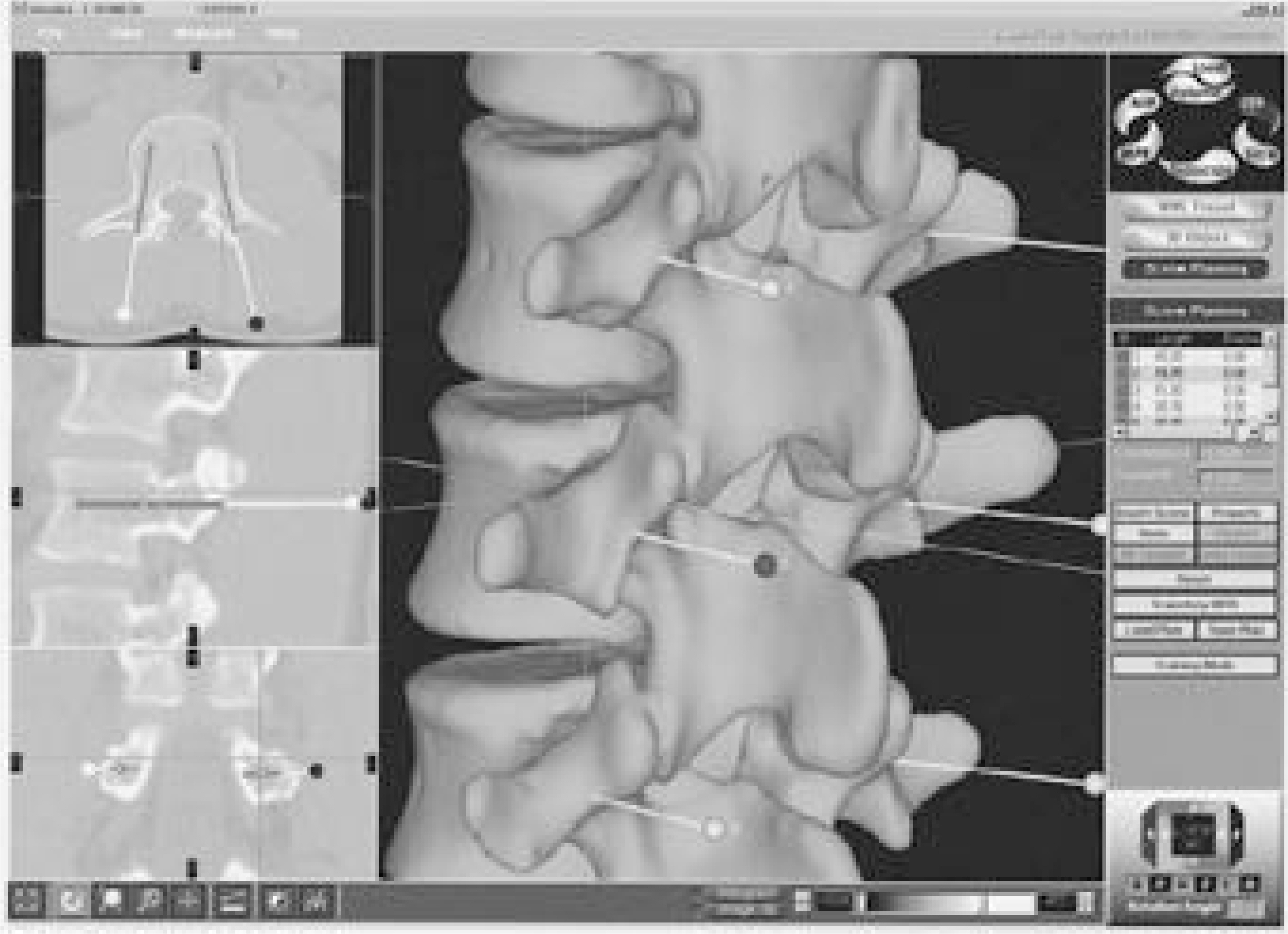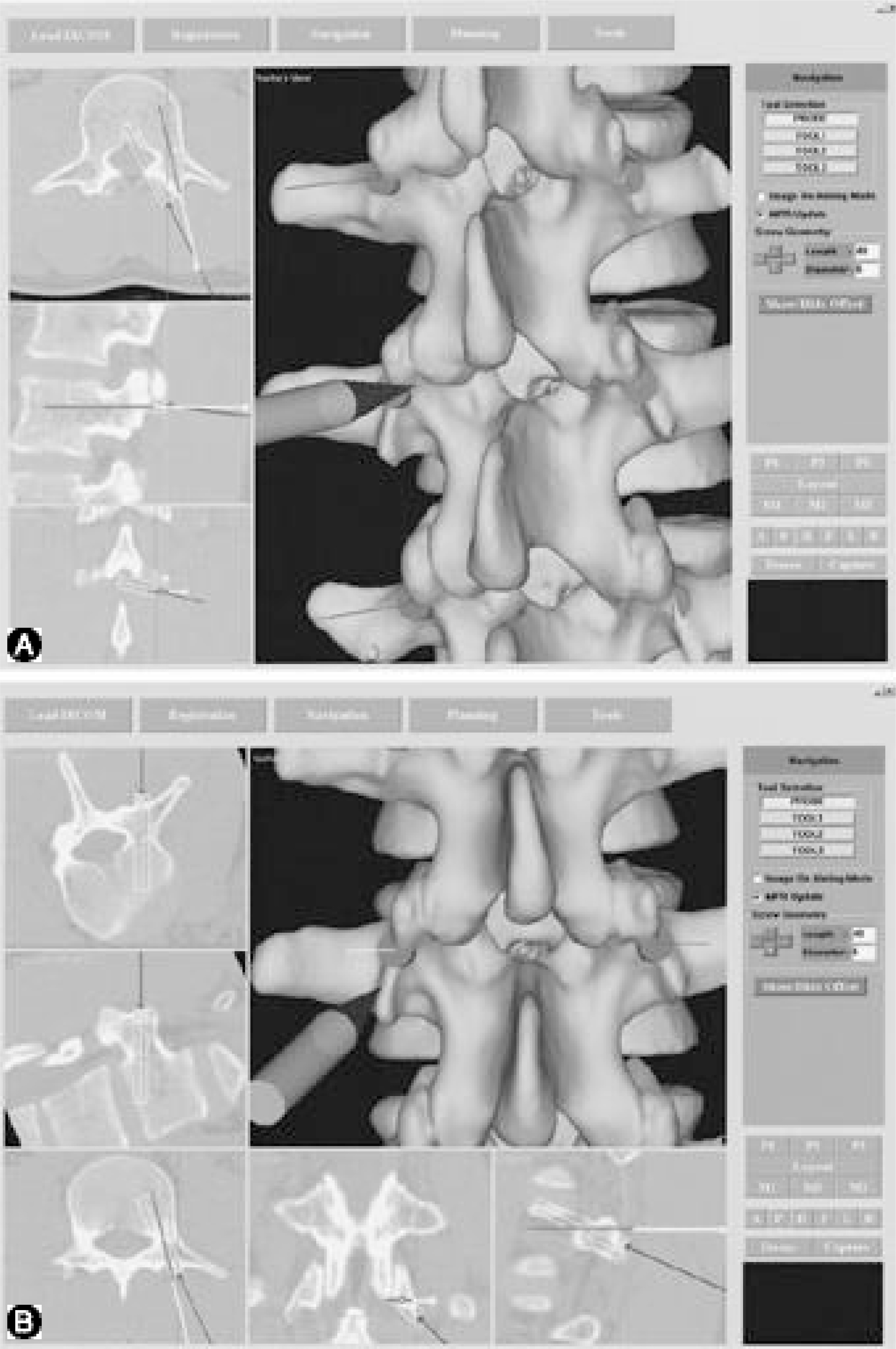J Korean Soc Spine Surg.
2002 Dec;9(4):270-279. 10.4184/jkss.2002.9.4.270.
A Robot Arm-type Navigation System for Pedicle Screw Placement: A Feasibility Study
- Affiliations
-
- 1Department of Orthopaedic Surgery, Eulji University, Daejeon, Korea.
- 2Department of Industrial Engineering, College of Engineering, Seoul National University, Seoul, Korea. yeongho@snu.ac.kr
- 3Cybermed Inc., Seoul, Korea.
- KMID: 2209708
- DOI: http://doi.org/10.4184/jkss.2002.9.4.270
Abstract
-
STUDY DESIGN: The study involved the development and accuracy testing of an intra-operative navigation system.
OBJECTIVES
This study was undertaken to develop a navigation system using a robot arm-type three-dimensional digitizer. And, to apply the developed system to pedicle screw insertion, and to evaluate its accuracy. SUMMARY OF LITERATURE REVIEW: To the best of our knowledge, no navigation system has been developed using a robot armtype three-dimensional digitizer.
MATERIALS AND METHODS
We have developed a navigator using a three-dimensional digitizer (Microscribe 3-D G2, Immersion, USA) supported by a personal computer. Four types of patient-to-image registration techniques were implemented. During navigation, the central axis of the robot arm's stylus and arm extension can be displayed over multi-planar and three-dimensional images, which are reconstructed from axial CT scan images. Registration errors and target localization errors of the navigation system were evaluated using a phantom made from a plastic lumbo-sacral bone model. The accuracy of pedicle screw insertion was also evaluated by placing 18 pedicle screws in such bone models.
RESULTS
The registration error was 0.78 +/- 0.27 mm at fiducial registration and 0.76 +/- 0.24 mm at hybrid registration, and the target localization error was 1.34 +/- 0.32 mm at fiducial registration and 1.28 +/- 0.29 mm at hybrid registration. Of the 18 screws placed in the plastic bone models, one (6%) screw breached the pedicle wall.
CONCLUSIONS
We have developed a robot arm-type three-dimensional digitizer-based navigation system for pedicle screw insertion, and found that its accuracy is equal or slightly better than that of optical tracker-based navigators.
MeSH Terms
Figure
Reference
-
1). Amin DV, LaBarca RS, Kanade T, DiGioia AM, Jara-maz B, Nikou C, Moody JE and Levison TJ. The iterative sampled image registration method. (in Syllabus of the 2nd annual meeting of the international society for computer assisted orthopaedic surgery. Santa Fe, The international society for computer assisted orthopaedic surgery. 170–172. 2002.2). Bodammer A, Koenig B, Scholz M, Kandziora F, Schnake K, Stockle U and Haas NP. Fluoroscopy-based navigation in the lumbar spine. (in Syllabus of the 2nd annual meeting of the international society for computer assisted orthopaedic surgery. Santa Fe, The international society for computer assisted orthopaedic surgery. 287. 2002.3). Boerner M and Wiesel U. European experience with an operative robot for primary and revision total hip - A summary of more than 3800 cases at BGU Frankfurt. (in Syllabus of computer assisted orthopaedic surgery USA 2001. Pittsburgh, The center for medical robotics and computer assisted surgery. 95–98. 2001.4). DiGioia AM, Jarmaz B and Colgan BD. Comp uter Assisted Orthopaedic Surgery. (in Syllabus of computer assisted orthopaedic surgery USA 2000. Pittsburgh, The center for medical robotics and computer assisted surgery. 31–39. 2000.5). Fritsch EW, Duchow J, Seil R, Grunwald I and Reith W. Accuracy of pedicle screw placement with virtual flu -oroscopy: A CT-controlled study. (in Syllabus of computer assisted orthopaedic surgery USA 2001. Pittsburgh, The center for medical robotics and computer assisted surgery. 207–208. 2001.6). Glossop ND, Cleary K and Banovac F. Needle tracking using the Aurora magnetic position sensor. (in Syllabus of the 2nd annual meeting of the international society for computer assisted orthopaedic surgery. Santa Fe, The international society for computer assisted orthopaedic surgery. 90–92. 2002.7). Huberson C, Merloz P, Tonetti J, Eid A, Blendea S, Martinez T, Plaweski S, Bouallag M and Badulescu A. Surgical navigation for spine: CT-based imaging versus virtual fluoroscopy. (in Syllabus of computer assisted orthopaedic surgery USA 2001. Pittsburgh, The center for medical robotics and computer assisted surgery. 203–205. 2001.8). Leonard MA and Weiner HL. Comparison of frameless stereotactic systems: accuracy, precision, and applications. Neurosurg. 49:1409–1415. 2001.9). Merloz P, Tonetti J, Eid A, Lavallee S and Pittet L. Pedicle screw placement in scoliosis: interest of CT-based navigation system. (in Syllabus of computer assisted orthopaedic surgery USA 2001. Pittsburgh, The center for medical robotics and computer assisted surgery. 209–211. 2001.10). Rampersaud YR, Montanera W and Salonen D. Com -puter-assisted cervicothoracic and thoracic pedicle screw placement. (in Syllabus of computer assisted orthopaedic surgery USA 2001. Pittsburgh, The center for medical robotics and computer assisted surgery. 213–215. 2001.11). Rampersaud YR, Pik JHT and Salonen D. Clinical accuracy of fluoroscopic computer-assisted pedicle screw placement. (in Syllabus of the 2nd annual meeting of the international society for computer assisted orthopaedic surgery. Santa Fe, The international society for computer assisted orthopaedic surgery. 130–132. 2002.12). Simon DA. The tool for CAOS: medical imaging, registration and tracking devices. (in Syllabus of computer assisted orthopaedic surgery USA 1998. Pittsburgh, The center for medical robotics and computer assisted surgery. 51–57. 1998.13). Taylor RH. Robotic assistive devices in orthopaedics. (in Syllabus of computer assisted orthopaedic surgery USA 1998. Pittsburgh, The center for medical robotics and computer assisted surgery. 59–66. 1998.14). Yeom JS, Choy WS, Kim WJ, Kim HY, Kang JW, Kim Y, Kim N and Lee JB. A patient-specific surgical simulation system for spinal screw insertion composed of virtual roentgenogram, virtual C-arm, and rapid prototyping. J of Korean Orthop Assoc. 36:161–166. 2001.
Article
- Full Text Links
- Actions
-
Cited
- CITED
-
- Close
- Share
- Similar articles
-
- Accuracy and Safety in Pedicle Screw Placement in the Thoracic and Lumbar Spines : Comparison Study between Conventional C-Arm Fluoroscopy and Navigation Coupled with O-Arm(R) Guided Methods
- Accuracy of Pedicle Screw Placement in Scoliosis Surgery: A Comparison between Conventional Computed Tomography-Based and O-Arm-Based Navigation Techniques
- Risk Factors of Unsatisfactory Robot-Assisted Pedicle Screw Placement: A Case-Control Study
- Accuracy of Pedicle Screw Insertion Using Fluoroscopy-Based Navigation-Assisted Surgery : Computed Tomography Postoperative Assessment in 96 Consecutive Patients
- Learning Curve for Robot-Assisted Percutaneous Pedicle Screw Placement in Thoracolumbar Surgery






